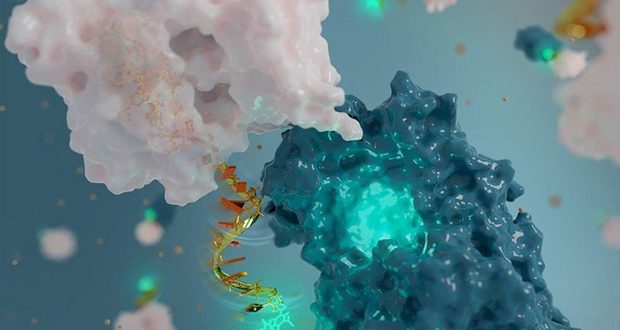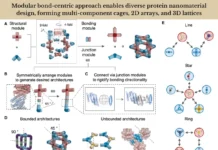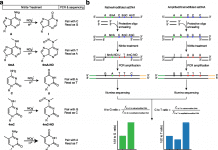A new DNA-based fluorescent nanoantenna is created by getting inspired by the ‘Lego-like’ properties of DNA. The building blocks of the new nanoantenna are typically 20,000 times smaller than human hair. A new DNA-based fluorescent nanoantenna will monitor the structural change of proteins over time. Results may go a long way to helping scientists better understand natural and human-designed nanotechnologies.
Researchers at the Université de Montréal have developed a nanoantenna to track protein movements. The gadget, published in Nature Methods, offers a novel approach to monitoring proteins’ structural changes over time. It might help scientists better comprehend both natural and human-designed nanotechnologies.
“The results are so exciting that we are currently working on setting up a start-up company to commercialize and make this nanoantenna available to most researchers and the pharmaceutical industry,” told professor Alexis Vallée-Bélisle, senior author of the study.
Image Source: Monitoring protein conformational changes using fluorescent nanoantennas
An antenna that functions similarly to a two-way radio
Researchers created the first DNA synthesizer more than 40 years ago to generate molecules that encode genetic information. “In recent years, chemists have realized that DNA can also be employed to build a variety of nanostructures and nanomachines,” told the researcher, who is the Canada Research Chair in Bioengineering and Bionanotechnology.
“Inspired by the ‘Lego-like’ properties of DNA, with building blocks that are typically 20,000 times smaller than a human hair, we have created a DNA-based fluorescent nanoantenna that can help characterize the function of proteins,” he stated.
“Like a two-way radio that can both receive and transmit radio waves, the fluorescent nanoantenna receives light in one colour, or wavelength, and depending on the protein movement it senses, then transmits light back in another colour, which we can detect.”
The receiver section of the antenna is also used to feel the molecular surface of the protein investigated via molecular contact, which is one of the primary novelties of these nanoantennae.
“One of the main advantages of using DNA to engineer these nanoantennas is that DNA chemistry is relatively simple and programmable,” added Scott Harroun, first author of the study.
“The DNA-based nanoantennas can be synthesized with different lengths and flexibilities to optimize their function,” he stated. “One can easily attach a fluorescent molecule to the DNA and then connect this fluorescent nanoantenna to a biological nanomachine, such as an enzyme.
“By carefully tuning the nanoantenna design, we have created five nanometer-long antenna that produces a distinct signal when the protein is performing its biological function.”
According to the researchers, fluorescent nanoantennas will provide new possibilities in biochemistry and nanotechnology.
“For example, we were able to detect, in real time and for the first time, the function of the enzyme alkaline phosphatase with a variety of biological molecules and drugs,” told Harroun. “This enzyme has been implicated in many diseases, including various cancers and intestinal inflammation.
“In addition to helping us understand how natural nanomachines function or malfunction, consequently leading to disease, this new method can also help chemists identify promising new drugs as well as guide nanoengineers to develop improved nanomachines,” said Dominic Lauzon, co-author in the study.
According to the researchers, one of the key advantages of these nanoantennas is their ease of usage.
“Perhaps what we are most excited by is the realization that many labs around the world, equipped with a conventional spectrofluorometer, could readily employ these nanoantennas to study their favourite protein, such as to identify new drugs or to develop new nanotechnologies,” said Vallée-Bélisle.
Story Source: Harroun, S. G., Lauzon, D., Ebert, M. C., Desrosiers, A., Wang, X., & Vallée-Bélisle, A. (2021). Monitoring protein conformational changes using fluorescent nanoantennas. Nature methods, 1-10.
Dr. Tamanna Anwar is a Scientist and Co-founder of the Centre of Bioinformatics Research and Technology (CBIRT). She is a passionate bioinformatics scientist and a visionary entrepreneur. Dr. Tamanna has worked as a Young Scientist at Jawaharlal Nehru University, New Delhi. She has also worked as a Postdoctoral Fellow at the University of Saskatchewan, Canada. She has several scientific research publications in high-impact research journals. Her latest endeavor is the development of a platform that acts as a one-stop solution for all bioinformatics related information as well as developing a bioinformatics news portal to report cutting-edge bioinformatics breakthroughs.












